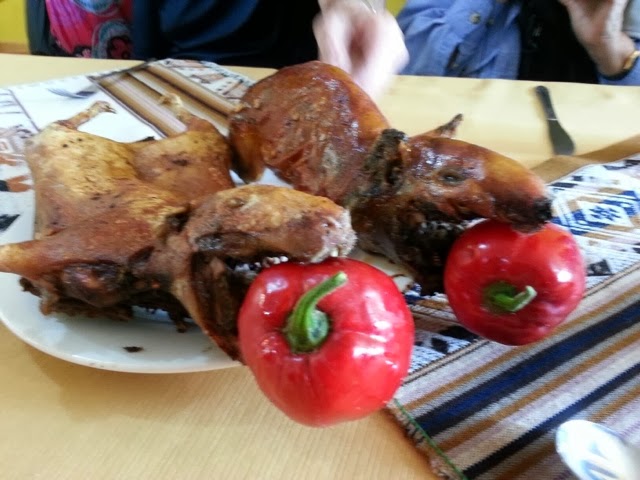It was an early morning today to catch the plane ride to Cusco. What a beautiful flight with us flying over the clouds and Andes Mountains. They would break up so i could take lots of beautiful photos of the Andes Mountains. (See photo.)
First on our agenda was the famous Factoria "La Vicunita" sweater factory. The owners taught us how to tell the difference between real baby alpaca and fake alpaca. Real alpaca is much softer and smoother; it feels cool to the touch and has a slightly shiny look. Then they let us go in their sale room. Each of us had a girl to help us find things our size, then she helped put them on us and gave us prices. They weren't pushy; they were there to help. It was like having a maid follow me around. This is different than at home, right?
After popular demand from our group, our tour guide took us to a small countryside zoo. There were almost all of the South American camelid groups represented. One of them is the vicuna, an endangered species. They have the finest fiber (hair) of all the camelids. I was lucky to photograph them since they are timid animals. (See photo.)
As we rode the bus, we saw the area surrounding Cusco. Many of the original Incan walls survive today since they were built so well. Communities have built on top of them. (See photo.) The countryside has many rural dwellings which are made of clay. Some of the homes have important symbols on the outside of them. (See photo.) Their backyards are where they dry their clothes, either on a clothesline or on shrubs. The animals they own live in the backyards. (See photo.) Some animals we have seen are small pigs, donkeys, llamas, alpacas, cattle, and chickens. Dogs are all over the place, with and without collars.
We rode a lot in the bus today to get to Urabamba. Around every mountain there was a new, beautiful view. Finally we made it to Pisaq which is a national park of Incan ruins. There were a few young men in traditional Peruvian costume that played handmade pipes. (See photo.) The music echoed through the countryside as we hiked around the mountain. On the mountains are terraces that the Incan people constructed.
We are staying in a beautiful, lodge style hotel with many little courtyards and gardens. It was too dark for photos today, but I will photograph them tomorrow. The internet connection is not always good at this hotel, so I don't know how many photos I'll be able to post. Don't worry though! In two days we will be staying in Cusco which should be better.
Questions for the Day:
There aren't many questions emailed today. Don't forget to email them to me at hartingbl@gmail.com otherwise you won't receive points! Do not share a document.
Many of the questions I did receive can be answered by rereading my blog posts. So be careful to ask questions that require me to write more about my experience, not repeat it.
Cole Travis- "Did you get some fresh fruit and how much did it cost?"
Answer- Yes, we have enjoyed a lot of fresh fruit at our hotel for breakfast. They are fresh, sweeter, and juicier. In the market, one piece of fruit is between 2 and 5 sol or about seventy-five cents to two dollars. My favorite is the watermelon and the small bananas. Mangos are pretty awesome too.
Nash Stewart- "What is the money system like?"
Answer- Peruvian money is called the Nuevo Sol or sol for short. $1 = 2.8 sol. I will bring some of their coins and paper money back with me to school. Some of their coins are silver and gold, very pretty. So, I can buy more here since the American dollar is worth more. Don't worry, our group is supporting the economy here by shopping.
Tomorrow we have a full day! We will take a raft ride down the Urabamba River, visit a school, go to another park with ruins, eat in a Peruvian home with a family, and shop at Seminaro, the pottery place. I'm having the time of my life and am glad to share it with you!
Have a great day!











































